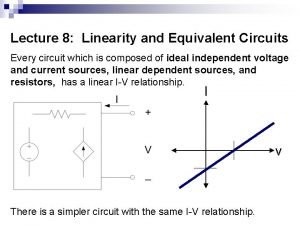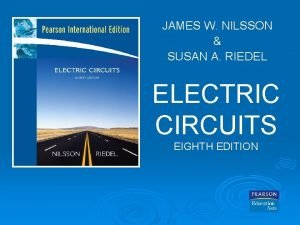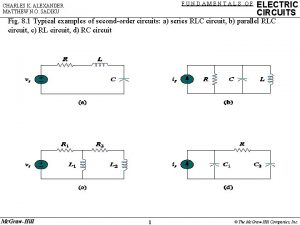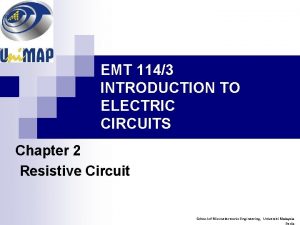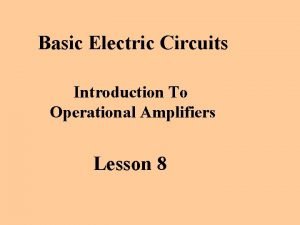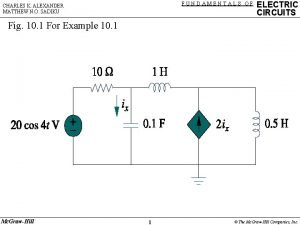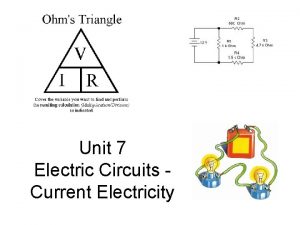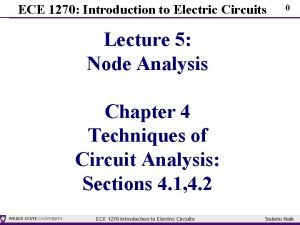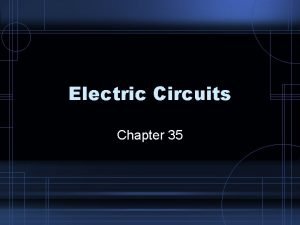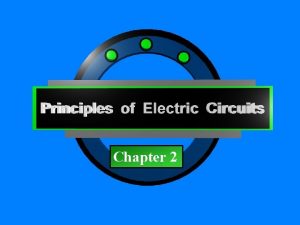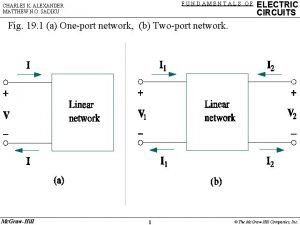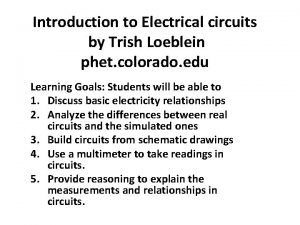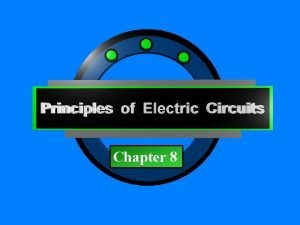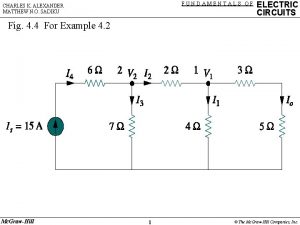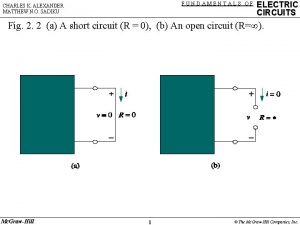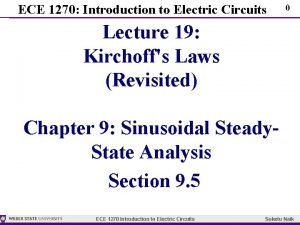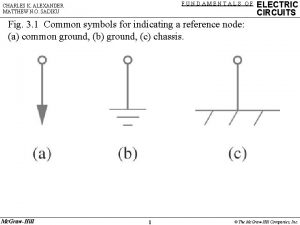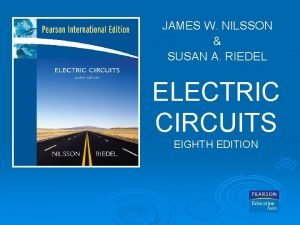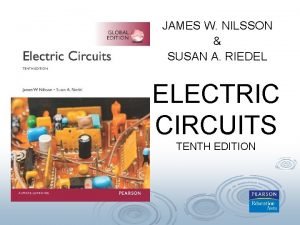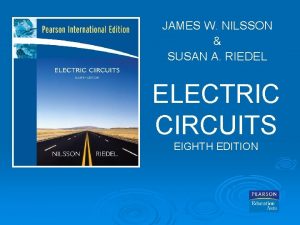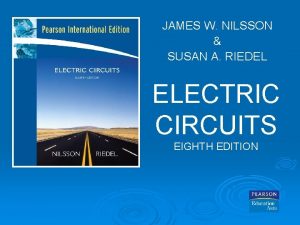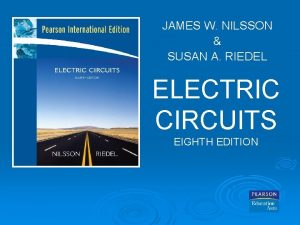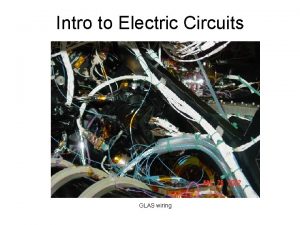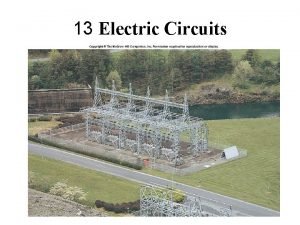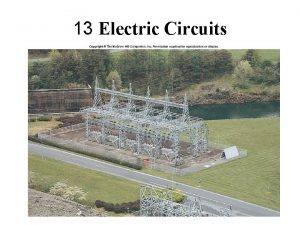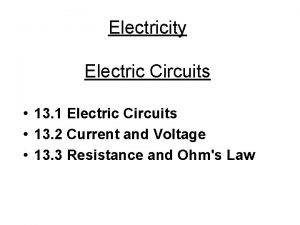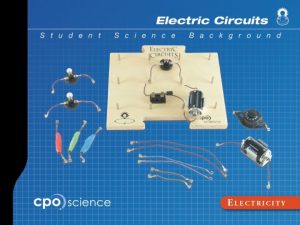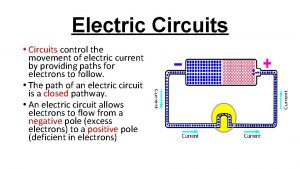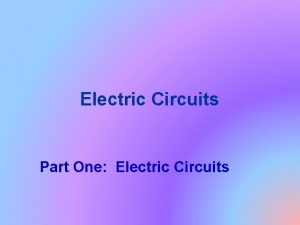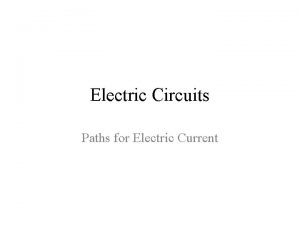JAMES W NILSSON SUSAN A RIEDEL ELECTRIC CIRCUITS


































- Slides: 34

JAMES W. NILSSON & SUSAN A. RIEDEL ELECTRIC CIRCUITS EIGHTH EDITION

CHAPTER 18 TWO-PORT CIRCUITS © 2008 Pearson Education

CONTENTS 18. 1 The Terminal Equations 18. 2 The Two-Port Parameters 18. 3 Analysis of the Terminated Two-Port Circuit 18. 4 Interconnected Two-Port Circuits © 2008 Pearson Education

18. 1 The Terminal Equations Two-Port Model Ø The two-port model is used to describe the performance of a circuit in terms of the voltage and current at its input and output ports. © 2008 Pearson Education

18. 1 The Terminal Equations The two-port building block © 2008 Pearson Education

18. 1 The Terminal Equations The s-domain two-port basic building block © 2008 Pearson Education

18. 1 The Terminal Equations Ø The model is limited to circuits in which: a) No independent sources are inside the circuit between the ports. b) No energy is stored inside the circuit between the ports. © 2008 Pearson Education

18. 1 The Terminal Equations c) The current into the port is equal to the current out of the port. d) No external connections exist between the input and output ports. © 2008 Pearson Education

18. 1 The Terminal Equations Ø Two of the four terminal variables (V 1, I 1, V 2, I 2) are independent; therefore, only two simultaneous equations involving the four variables are needed to describe the circuit. © 2008 Pearson Education

18. 1 The Terminal Equations Ø The six possible sets of simultaneous equations involving the four terminal variables are called the z-, y-, a-, b-, h-, and g-parameter equations. © 2008 Pearson Education

18. 1 The Terminal Equations © 2008 Pearson Education

18. 1 The Terminal Equations © 2008 Pearson Education

18. 1 The Terminal Equations © 2008 Pearson Education

18. 1 The Terminal Equations Ø The parameter equations are written in the s domain. Ø The dc values of the parameters are obtained by setting s = 0, and the sinusoidal steady-state values are obtained by setting s = j . © 2008 Pearson Education

18. 2 The Two-Port Parameters Ø Any set of parameters may be calculated or measured by invoking appropriate shortcircuit and open-circuit conditions at the input and output ports. © 2008 Pearson Education

18. 2 The Two-Port Parameters © 2008 Pearson Education

18. 2 The Two-Port Parameters Example: Finding the z Parameters of a Two-Port Circuit. Find the z parameters for the circuit shown in below. © 2008 Pearson Education

18. 2 The Two-Port Parameters The relationships among the six sets of parameters are given in this table: Parameter conversion table © 2008 Pearson Education

18. 2 The Two-Port Parameters ØA two-port circuit is reciprocal if the interchange of an ideal voltage source at one port with an ideal ammeter at the other port produces the same ammeter reading. © 2008 Pearson Education

18. 2 The Two-Port Parameters Ø The effect of reciprocity on the two -port parameters is given by: © 2008 Pearson Education

18. 2 The Two-Port Parameters A reciprocal two-port circuit © 2008 Pearson Education

18. 2 The Two-Port Parameters ØA reciprocal two-port circuit is symmetric if its ports can be interchanged without disturbing the values of the terminal currents and voltages. A circuit with the voltage source and ammeter interchanged © 2008 Pearson Education

18. 2 The Two-Port Parameters ØFour examples of symmetric two-port circuits. A symmetric tee A symmetric pi © 2008 Pearson Education

18. 2 The Two-Port Parameters A symmetric bridged tee A symmetric lattice © 2008 Pearson Education

18. 3 Analysis of the Terminated Two-Port Circuit Ø To illustrate how the six characteristics are derived, we develop the expressions using the z parameters to model the two-portion of the circuit. Ø The next tables summarize the expressions involving the y, a, b, h, and g parameters. © 2008 Pearson Education

18. 3 Analysis of the Terminated Two-Port Circuit Terminated two-port equations © 2008 Pearson Education

18. 3 Analysis of the Terminated Two-Port Circuit Terminated two-port equations © 2008 Pearson Education

18. 3 Analysis of the Terminated Two-Port Circuit Terminated two-port equations © 2008 Pearson Education

18. 3 Analysis of the Terminated Two-Port Circuit Example: Analyzing a Terminated Two-Port Circuit. The two-port circuit shown below is described in terms of its b parameters, the values of which are b 11 = -20, b 12 = -3000Ω, b 21 = -2 m. S, b 22 = -0. 2 a) Find the phasor voltage V 2. b) Find the average power delivered to the 5 kΩ load. c) Find the average power delivered to the input port. d) Find the load impedance for maximum average power transfer. e) Find the maximum average power delivered to the load in (d). © 2008 Pearson Education

18. 4 Interconnected Two-Port Circuits ØLarge networks can be divided into subnetworks by means of interconnected two-port models. © 2008 Pearson Education

18. 4 Interconnected Two-Port Circuits (a) Cascade (b) Series © 2008 Pearson Education (c) Parallel

18. 4 Interconnected Two-Port Circuits (d) Series-parallel (e) Parallel-series © 2008 Pearson Education

18. 4 Interconnected Two-Port Circuits A cascade connection © 2008 Pearson Education

THE END © 2008 Pearson Education
 Electric circuits by james nilsson and susan riedel
Electric circuits by james nilsson and susan riedel Thevenin and norton examples
Thevenin and norton examples James w nilsson
James w nilsson What is a parallel circuit in physics
What is a parallel circuit in physics Chapter 35 electric circuits answers
Chapter 35 electric circuits answers Electric circuits fundamentals floyd
Electric circuits fundamentals floyd Fundamentals of electric circuits chapter 4 solutions
Fundamentals of electric circuits chapter 4 solutions Sadiku
Sadiku Quarturs
Quarturs Introduction to electric circuits
Introduction to electric circuits Electric circuits equations
Electric circuits equations Sadiku
Sadiku Ohms law worksheet
Ohms law worksheet Electric circuits
Electric circuits Electric current
Electric current Elec 202
Elec 202 Fundamentals of electric circuits chapter 9 solutions
Fundamentals of electric circuits chapter 9 solutions Basic electrical engineering kulshreshtha
Basic electrical engineering kulshreshtha Introduction to electric circuits
Introduction to electric circuits Chapter 35 electric circuits
Chapter 35 electric circuits Three elements of a basic program for electrical safety are
Three elements of a basic program for electrical safety are Principle of electric circuit
Principle of electric circuit Alexander
Alexander Conceptual physics chapter 35
Conceptual physics chapter 35 Electric circuits grade 6
Electric circuits grade 6 Fundamentals of electric circuits chapter 7 solutions
Fundamentals of electric circuits chapter 7 solutions Phet build a circuit
Phet build a circuit Principles of electric circuits 10th edition answer key
Principles of electric circuits 10th edition answer key Charles k. alexander matthew n. o. sadiku
Charles k. alexander matthew n. o. sadiku Alexander and sadiku
Alexander and sadiku Chapter 20 electric circuits
Chapter 20 electric circuits Introduction to electric circuits
Introduction to electric circuits Charles k. alexander matthew n. o. sadiku
Charles k. alexander matthew n. o. sadiku Ryszard riedel biografia
Ryszard riedel biografia Klaus riedel
Klaus riedel

